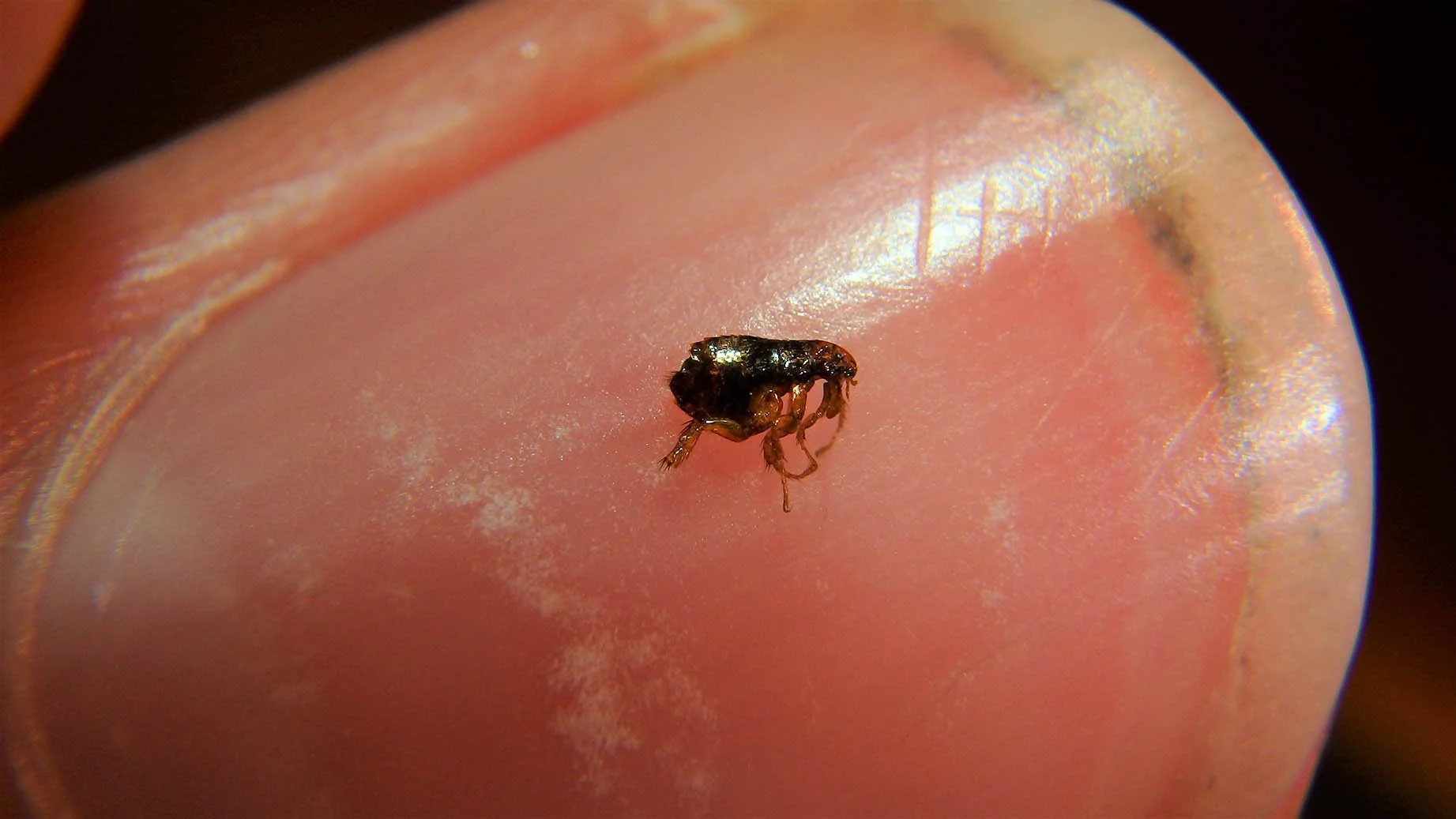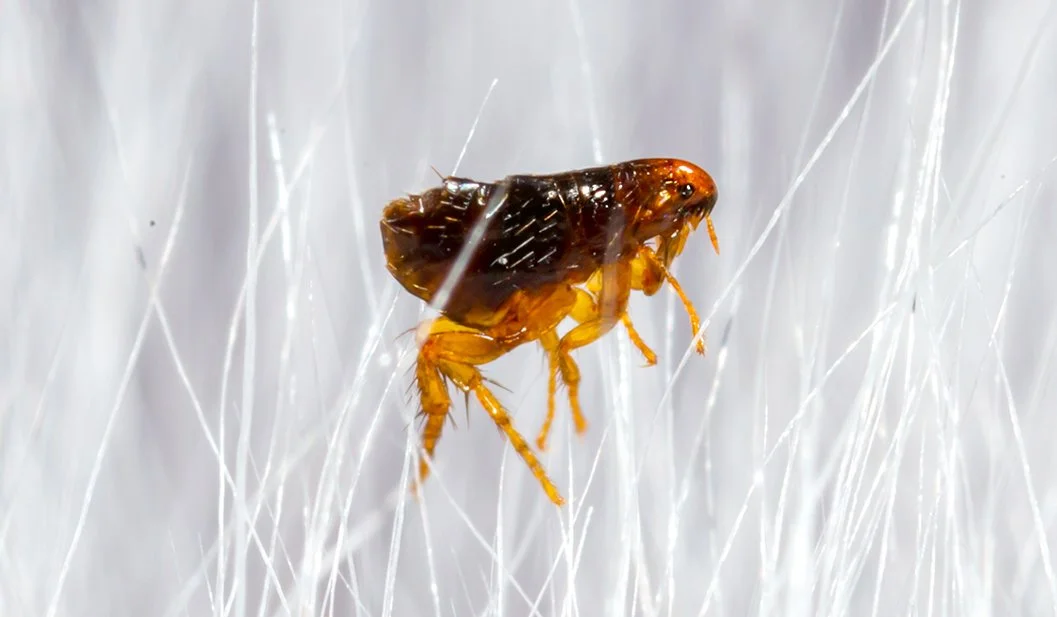Fleas
In Southern California, fleas are an unfortunate reality, with the Cat Flea being the most common species. These pesky parasites primarily feed on warm-blooded creatures, including pets and humans, and often travel from wildlife like raccoons, skunks, and opossums. While they might seem like small annoyances, fleas are responsible for a range of health issues, from itchy bites to serious diseases like the Bubonic Plague.
The fleas start their journey by hiding in shaded foliage or areas where they can attach themselves to passing animals. Once inside your home, they can spread quickly by hiding in carpets, furniture, pet bedding, and even clothing. Fleas can be incredibly tricky to get rid of, as they lay eggs that fall off their hosts and hatch into larvae, continuing the cycle.



Understanding the Flea Life Cycle in SoCal
In Southern California's warm climate, fleas thrive nearly year-round, making them a persistent threat to both pets and homes. To effectively control an infestation, it’s essential to understand the flea life cycle, and why acting fast is critical.
-
Egg – Adult fleas lay up to 50 eggs per day, often falling off pets into carpets, pet bedding, and cracks in floors.
Larva – Flea larvae hatch in 2–5 days and burrow into dark, humid areas to feed on organic debris and flea dirt.
Pupa – In this stage, fleas develop inside a silken cocoon. Pupae can remain dormant for weeks or even months, waiting for the right conditions.
Adult – Triggered by warmth and vibration, adult fleas emerge and immediately look for a host to feed on, usually your pets or family members.
SoCal’s mild winters allow fleas to survive outdoors and indoors without interruption. This means skipping flea prevention—even in cooler months—can lead to quick infestations.
How Do Fleas Get Into Your Home?
Even the cleanest homes can fall victim to a flea infestation. These tiny pests are persistent hitchhikers, finding sneaky ways to enter your space. Understanding how fleas get inside is the first step to preventing an outbreak.
-
Pets – Dogs and cats can carry fleas indoors after playing or walking outside.
Wildlife – Animals like raccoons, squirrels, or opossums nesting near your home may drop flea eggs in your yard.
Clothing & Shoes – Fleas can latch onto your pants, socks, or shoes and catch a ride inside.
Used Furniture or Rugs – Secondhand items may come with uninvited guests already hiding in the fabric.
Visitors – Fleas can tag along on guests who unknowingly bring them in.
Once inside, fleas can lay hundreds of eggs in your carpets, bedding, and upholstery, making them difficult to eliminate without professional treatment.
Outdoor Flea Prevention
Flea infestations often start outdoors, especially in warm, humid areas like Southern California. Fleas thrive in shady, moist environments and can easily hitch a ride indoors via pets, wildlife, or even your shoes. Taking proactive steps outside your home is key to preventing fleas from taking hold.
-
Keep grass trimmed – Fleas love tall grass and overgrown areas. Regular mowing reduces their hiding spots.
Remove leaf litter and debris – Clean up piles of leaves, wood, and brush where fleas and wildlife can nest.
Limit wildlife access – Use fencing and remove attractants like pet food to keep raccoons, opossums, and stray animals away.
Create a barrier – Gravel or mulch borders between your lawn and home foundation can reduce flea migration indoors.
Seal entry points – Repair gaps in screens, doors, and vents to reduce flea-carrying rodents and pests from entering the home.
Diseases Fleas Can Transmit
Fleas are more than just an itchy annoyance; they can be dangerous disease carriers, especially when they infest rodents or come into contact with pets and humans. These tiny pests have the potential to spread serious illnesses that still pose risks today.
-
Bubonic Plague – Known as one of the deadliest pandemics in history, the plague is still present in some regions and can be transmitted by fleas that bite infected rodents.
Murine Typhus – A bacterial disease spread by fleas, often associated with urban and suburban rodent populations, including rats and opossums.
Tapeworms – Fleas can carry tapeworm larvae, which can be ingested by pets—especially cats and dogs—during grooming, leading to internal parasite infections.
Preventing flea infestations is key to protecting your home, your family, and your pets from these potential health threats.
Flea Prevention for Pets
Keeping your pets flea-free is essential for their health, and your home’s comfort. Fleas are not only irritating, they can also transmit diseases and cause allergic reactions, skin infections, and tapeworms. With Southern California's mild climate, flea prevention needs to be a year-round priority.
-
Use vet-approved flea treatments – Choose monthly topical solutions, oral medications, or flea collars based on your pet's needs.
Regular grooming – Bathe and brush pets frequently to spot and remove fleas early.
Vacuum frequently – Flea eggs and larvae hide in carpets, rugs, and pet bedding.
Wash pet bedding – Clean bedding in hot water weekly to kill flea eggs and larvae.
Fleas Without Pets
Even if you don’t own pets, fleas can still invade your home. Fleas can easily jump onto your clothing or belongings when walking through infested areas like parks, neighborhoods, or public places. Fleas can even latch onto rodents that might infest your home, turning your living space into their new host.
By understanding flea behavior, recognizing the importance of preventive measures, and acting swiftly if an infestation occurs, you can protect your home and loved ones from these tiny yet impactful pests.


